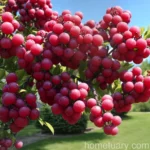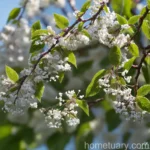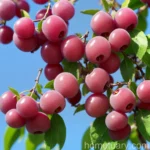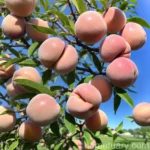The Fascinating World of Peach Trees: Prunus Persica ‘Bonanza’
Peaches are undoubtedly one of the most beloved fruits in the world, known for their juicy and sweet flesh. The peach tree, scientifically known as Prunus persica, produces this delectable fruit and is revered for its aesthetic appeal as an ornamental fruit tree as well. Among the diverse varieties of peaches, the ‘Bonanza’ cultivar is particularly interesting due to its dwarf size, making it an ideal choice for small spaces and container gardening. In this comprehensive guide, we will delve into the captivating realm of Prunus persica ‘Bonanza’, exploring its cultivation, care, and various aspects that contribute to its overall health and productivity.
What is a Peach Tree?
Peach trees (Prunus persica) are deciduous trees originating from the region of Northwest China. These fruit-bearing plants belong to the Prunus genus, which also includes cherry, apricot, almond, and plum trees. The peach tree, known for its attractive pink blooms in spring, produces delicious, fuzzy fruits that are admired for their succulent taste and versatility in culinary applications. The peach fruit is botanically classified as a drupe, characterized by its single large seed encased in a tough, woody endocarp surrounded by juicy edible flesh.
Key Takeaways – Peach (Prunus persica ‘Bonanza’)
- Peach Tree: A fruit-bearing deciduous tree that belongs to the Prunus genus.
- Prunus Persica: The scientific name for the peach tree.
- Bonanza Peach: A specific cultivar of peach known for its compact, dwarf size.
- Dwarf Peach Tree: Refers to a smaller-sized peach tree, such as the ‘Bonanza’ cultivar.
- Fruit Trees: Refers to trees that bear edible fruits.
- Prunus Genus: The genus to which the peach tree belongs, encompassing various other fruit-bearing trees.
- Peach Varieties: Diverse cultivars and types of peaches available.
- Ornamental Fruit Tree: A fruit-bearing tree valued for its aesthetic appeal.
- Pruning Peach Trees: The practice of trimming and shaping peach trees to promote optimal growth and fruit production.
- Growing Bonanza Peach: Cultivating and nurturing the ‘Bonanza’ peach cultivar.
- Prunus Persica Cultivars: Different cultivated varieties within the peach species.
- Backyard Fruit Trees: Fruit trees planted within the confines of a residential property.
- Small Space Fruit Trees: Fruit trees suitable for cultivation in limited or confined spaces.
- Miniature Peach Tree: Refers to small-sized peach trees, ideal for restricted planting areas.
- Bonanza Peach Care: The specific care and maintenance required for the ‘Bonanza’ peach cultivar.
- Fruit-Bearing Plants: Plants that produce edible fruits, encompassing a wide range of botanical species.
- Edible Landscape Plants: Plants suitable for both ornamental and culinary purposes within a landscape setting.
- Dwarf Fruit Trees: Small-sized fruit trees, such as the ‘Bonanza’ peach cultivar.
- Bonanza Peach Tree Description: Characteristics and features of the ‘Bonanza’ peach tree.
- Self-Pollinating Fruit Trees: Trees capable of pollinating themselves without requiring external pollinators.
- Growing Peaches in Containers: Cultivating peach trees within containers or pots.
- Bonanza Peach Tree Size: The typical size and dimensions of the ‘Bonanza’ peach tree.
- Fruit Tree Diseases: Various diseases that can affect fruit-bearing trees, including peaches.
- Bonanza Peach Tree Pruning Guide: Specific guidelines for pruning the ‘Bonanza’ peach tree.
- Container Gardening with Peaches: Growing peach trees in containerized environments.
- Bonanza Peach Harvest: The process of harvesting ripe fruits from the ‘Bonanza’ peach tree.
- Hardy Fruit Trees: Fruit trees known for their resilience and ability to withstand adverse conditions.
- Indoor Peach Trees: Peach trees cultivated within indoor or greenhouse settings.
- Bonanza Peach Tree Pollination: The process of pollination in ‘Bonanza’ peach trees.
- Climate Requirements for Peach Trees: Optimal environmental conditions necessary for peach tree growth.
- Common Peach Tree Problems: Typical issues and challenges encountered in peach tree cultivation.
- Bonanza Peach Tree Maintenance: Ongoing care and upkeep of the ‘Bonanza’ peach tree.
- Fruit Tree Fertilization: The application of nutrients to promote the healthy growth of fruit trees.
- Bonanza Peach Tree Planting: Guidelines and considerations for planting ‘Bonanza’ peach trees.
- Pest Management for Peach Trees: Strategies for preventing and controlling pests that affect peach trees.
- Bonanza Peach Tree Lifespan: The typical lifespan and longevity of ‘Bonanza’ peach trees.
- Fruit Tree Pruning Techniques: Various methods and techniques for pruning fruit-bearing trees.
- Bonanza Peach Tree Sunlight Requirements: The amount of sunlight essential for the optimal growth of ‘Bonanza’ peach trees.
- Organic Peach Growing: Cultivating peaches using organic and sustainable practices.
- Bonanza Peach Tree Watering Needs: The specific water requirements of ‘Bonanza’ peach trees.
- Winter Care for Peach Trees: Protective measures and care during the winter season for peach trees.
- Bonanza Peach Tree Soil Requirements: The ideal soil conditions for growing ‘Bonanza’ peach trees.
- Natural Pest Control for Peach Trees: Utilizing natural means to manage pests affecting peach trees.
- Bonanza Peach Tree Growth Rate: The rate at which ‘Bonanza’ peach trees typically grow.
- Peach Tree Blooming Season: The period during which peach trees produce their characteristic blossoms.
- Bonanza Peach Tree Root System: The root structure and development of ‘Bonanza’ peach trees.
- Tips for Successful Peach Cultivation: Valuable advice and recommendations for successful peach tree cultivation.
- Bonanza Peach Tree Companion Plants: Other plant species that can be grown alongside ‘Bonanza’ peach trees.
- Blossom and Fruit Development in Peach Trees: The stages of flower and fruit production in peach trees.
- Bonanza Peach Tree Diseases and Treatments: Common diseases affecting ‘Bonanza’ peach trees and their treatments.
Now that we have familiarized ourselves with the overarching themes and keywords related to Prunus persica ‘Bonanza’, let’s delve deeper into the culture, uses, and essential care practices for this captivating peach cultivar.
Culture of Prunus Persica ‘Bonanza’
Cultivating peaches, especially the ‘Bonanza’ cultivar, involves understanding and implementing specific cultural practices that are conducive to the tree’s growth and fruit production. The cultural requirements encompass various aspects such as water, sunlight, fertilizer, soil, pruning, and propagation.
Water
-
Watering Needs: Peach trees, including the ‘Bonanza’ cultivar, require consistent and adequate moisture, especially during the growing season and fruit development phase. Providing a deep and thorough watering once or twice a week is generally recommended, ensuring that the soil is sufficiently moist but not waterlogged. During dry and hot periods, additional watering may be necessary to prevent water stress and maintain the tree’s vitality.
-
Irrigation Methods: Drip irrigation or soaker hoses can be beneficial for delivering water directly to the root zone, promoting efficient water utilization and minimizing the risk of fungal diseases that can result from foliage wetting. Mulching the base of the tree with organic matter aids in moisture retention and soil insulation, contributing to a more stable and suitable growing environment for the ‘Bonanza’ peach tree.
Sunlight
-
Sunlight Requirements: Peach trees thrive in full sun, necessitating a minimum of 6-8 hours of direct sunlight daily for optimal growth and fruit production. Adequate sunlight exposure ensures the development of strong, fruit-bearing branches and promotes the accumulation of sugars in the fruits, enhancing their flavor and sweetness.
-
Site Selection: When planting ‘Bonanza’ peach trees, it’s crucial to choose a location that receives ample sunlight and offers protection from strong winds, as excessively windy conditions can lead to fruit and branch damage. South-facing or west-facing locations are often ideal for ensuring the necessary sunlight exposure for the tree.
Fertilizer
-
Nutrient Requirements: Providing the ‘Bonanza’ peach tree with appropriate fertilization is essential for supporting its growth, blossoming, and fruiting. Utilizing a balanced, slow-release fertilizer formulated for fruit trees can supply the necessary nutrients, including nitrogen, phosphorus, and potassium, without inducing excessive vegetative growth. Before the budding stage in early spring, applying a granular fertilizer around the tree’s drip line, following the manufacturer’s guidelines, contributes to the tree’s overall vigor.
-
Organic Fertilization: Organic fertilizers such as compost, well-rotted manure, or fish emulsion can serve as natural alternatives, enriching the soil with essential nutrients and enhancing its microbial activity. These organic amendments benefit the ‘Bonanza’ peach tree by promoting soil structure, moisture retention, and long-term fertility, fostering a balanced and sustainable approach to tree nourishment.
Soil
-
Soil Preferences: ‘Bonanza’ peach trees thrive in well-draining, loamy soil with a slightly acidic to neutral pH range of 6.0-7.0. The soil should be rich in organic matter, providing a favorable medium for root development and nutrient uptake. Conducting a soil test prior to planting can offer valuable insights into the soil’s composition and pH, enabling adjustments and amendments as necessary to create an optimal growing environment for the peach tree.
-
Amendment and Mulching: Incorporating organic amendments such as compost, peat moss, or well-rotted manure into the soil during planting or as topdressing contributes to soil fertility and structure. Additionally, applying a layer of organic mulch, such as wood chips or straw, around the base of the tree aids in moisture retention, weed suppression, and temperature moderation, fostering a conducive soil environment for the ‘Bonanza’ peach tree.
Pruning
-
Pruning Objectives: Pruning plays a crucial role in shaping the structure of ‘Bonanza’ peach trees, promoting adequate air circulation, light penetration, and fruit-bearing wood development. The primary objectives of pruning peach trees include maintaining an open center or vase-shaped canopy, removing dead or diseased wood, and thinning out excess growth to enhance fruit quality and yield.
-
Pruning Techniques: Conducting annual pruning during the dormant season, preferably in late winter to early spring before bud break, is recommended for the ‘Bonanza’ peach tree. This practice facilitates the removal of non-productive wood, encouraging the tree to allocate its resources towards the production of healthy, flavorful fruits. Thinning the fruit clusters after the fruit has set promotes adequate spacing and prevents overcrowding, contributing to larger and better-quality peaches.
Propagation
-
Propagation Methods: While commercial propagation of ‘Bonanza’ peach trees is often carried out through budding or grafting onto suitable rootstocks, home gardeners can also propagate this cultivar through simple methods such as hardwood cuttings or even from seed, although the latter approach can take longer to yield fruit-bearing trees. Propagation through cuttings entails selecting healthy, disease-free branches and treating them with a rooting hormone before planting them in a well-draining propagation medium.
-
Timing and Considerations: Propagation activities are typically performed during the dormant season or early spring, enabling the newly propagated trees to establish themselves before the onset of active growth. Adequate humidity and consistent moisture are essential during the initial stages of propagation to support root development and overall plant survival.
Uses of Prunus Persica ‘Bonanza’
The ‘Bonanza’ peach cultivar offers a myriad of uses and benefits, ranging from its delectable fruits to its ornamental value and adaptability to container gardening. Understanding the diverse applications and utilities of this unique cultivar provides insight into the versatility and appeal of Prunus persica ‘Bonanza’.
-
Edible Fruits: The primary use of the ‘Bonanza’ peach tree lies in the production of its flavorful, juicy fruits, which can be enjoyed fresh, incorporated into various culinary dishes, or preserved through canning, freezing, or drying methods. The fruits are renowned for their sweet taste, vibrant color, and aromatic fragrance, making them a delightful addition to both sweet and savory recipes.
-
Ornamental Appeal: In addition to its fruit-bearing capabilities, the ‘Bonanza’ peach tree offers ornamental value, especially during the spring season when it bursts into a profusion of pink blossoms. These showy blooms not only enhance the aesthetic appeal of the tree but also attract pollinators such as bees, contributing to the overall biodiversity and health of the garden or landscape.
-
Container Gardening: Due to its compact and dwarf habit, the ‘Bonanza’ peach tree is well-suited for container gardening, allowing individuals with limited space or urban dwellers to cultivate this fruit-bearing tree on patios, balconies, or small outdoor areas. The adaptability of ‘Bonanza’ peaches to containerized environments extends the joy of growing and harvesting fresh fruits to a broader audience, bridging the gap between urban lifestyles and horticultural pursuits.
-
Edible Landscape: Incorporating ‘Bonanza’ peach trees into edible landscaping designs not only provides a source of homegrown fruits but also contributes to the overall aesthetics of the outdoor space. The lush green foliage, colorful blossoms, and eventual harvest of ripe peaches add a dynamic and functional element to the landscape, merging practicality with visual charm.
Popularity of Prunus Persica ‘Bonanza’
The ‘Bonanza’ peach cultivar has garnered significant popularity among home gardeners, landscape enthusiasts, and horticultural communities due to its unique characteristics, compact size, and suitability for diverse cultivation scenarios. As an esteemed member of the Prunus persica species, the ‘Bonanza’ peach tree continues to captivate individuals seeking to incorporate fruit-bearing and ornamental trees into their outdoor spaces.
Residential Gardens and Orchards
- The ‘Bonanza’ peach cultivar is embraced by homeowners and gardening enthusiasts seeking to establish backyard fruit trees that not only yield delectable fruits but also enhance the visual appeal of the landscape. Its diminutive size makes it an ideal choice for smaller yards and urban gardens, where space limitations may preclude the cultivation of larger fruit trees. The allure of harvesting ripe peaches directly from one’s garden underscores the enduring appeal of the ‘Bonanza’ peach tree in residential settings.
Urban and Small-Space Gardening
- The compact nature of the ‘Bonanza’ peach tree aligns with the growing interest in urban and small-space gardening, catering to individuals living in apartments, condominiums, or compact residences. Its adaptability to container gardening allows urban dwellers to partake in the joy of fruit tree cultivation, adding a touch of greenery and productivity to their outdoor living spaces.
Landscape and Ornamental Appeal
- Beyond its fruit-bearing capabilities, the ‘Bonanza’ peach tree contributes to landscape diversity and ornamental charm through its seasonal displays of blossoms, lush foliage, and eventual fruit production. As a component of edible landscaping, the ‘Bonanza’ peach cultivar harmoniously merges practical fruit production with aesthetic enhancements, enriching the visual and functional aspects of outdoor environments.
Common Diseases and Pests of Prunus Persica ‘Bonanza’
The health and vitality of the ‘Bonanza’ peach tree can be influenced by various diseases and pests that affect the overall well-being of the plant. Understanding the potential challenges and implementing proactive measures for disease management and pest control is crucial in safeguarding the ‘Bonanza’ peach tree’s productivity and longevity.
Common Diseases
-
Peach Leaf Curl (Taphrina deformans): A prevalent fungal disease affecting peach trees, peach leaf curl results in the distortion and reddening of leaves, ultimately leading to defoliation and reduced vigor. Protective fungicidal sprays applied during the dormant season and before bud swell can effectively mitigate the occurrence of peach leaf curl, preserving the foliage and overall health of the ‘Bonanza’ peach tree.
-
Brown Rot (Monilinia fructicola): This fungal pathogen targets the fruits of peach trees, inducing the development of brown, mummified lesions and decay. Employing proper sanitation practices, such as removing and disposing of infected fruits, as well as applying fungicidal sprays during critical growth stages, helps manage and prevent the spread of brown rot in ‘Bonanza’ peach trees.
-
Bacterial Spot (Xanthomonas arboricola): Characterized by the appearance of small, raised lesions on leaves and fruits, bacterial spot can compromise the overall health and aesthetics of peach trees. Employing copper-based fungicides and adhering to appropriate irrigation practices can aid in reducing bacterial spot incidence in the ‘Bonanza’ peach cultivar.
-
Peach Scab (Cladosporium carpophilum): This fungal disease presents as dark, velvety spots on the fruit surface, diminishing the marketability and quality of the peaches. Utilizing fungicidal applications and cultural practices such as adequate spacing between trees and proper air circulation can mitigate the impact of peach scab on ‘Bonanza’ peach trees.
Disease Diagnosis
Diagnosing diseases in ‘Bonanza’ peach trees involves careful observation of foliage, fruits, and overall tree health, as well as noting any environmental stressors or cultural deficiencies that may contribute to disease development. Conducting regular inspections and seeking professional assistance in identifying and addressing potential diseases are essential in preventing widespread outbreaks and minimizing the impact on the tree’s productivity and vigor.
Common Pests
-
Peach Twig Borer (Anarsia lineatella): This pest targets the tender shoots and twigs of peach trees, leading to dieback and diminished growth. Monitoring for the presence of peach twig borers and implementing trunk banding or targeted insecticide applications aids in managing their populations and protecting ‘Bonanza’ peach trees from infestation.
-
Peachtree Borer (Synanthedon exitiosa): The larvae of the peachtree borer bore into the trunk and branches of peach trees, causing structural damage and weakening the tree’s overall resilience. Utilizing pheromone traps, applying preventive insecticidal treatments, and maintaining tree vigor through proper cultural practices are crucial in combatting the peachtree borer and preserving the health of ‘Bonanza’ peach trees.
-
Scale Insects (Various species): Scale insects, such as San Jose scale and white peach scale, can infest the twigs and branches of peach trees, leading to reduced sap flow and overall vigor. Implementing horticultural oils, natural predators, and targeted insecticidal applications assists in managing scale insect populations and safeguarding the health of ‘Bonanza’ peach trees.
-
Aphids (Various species): Aphids, including the green peach aphid, can colonize peach trees, causing stunted growth, honeydew secretion, and leaf distortion. Natural predators, such as ladybugs and lacewings, as well as selective insecticidal treatments, aid in controlling aphid populations and protecting ‘Bonanza’ peach trees from detrimental infestations.
Botanist’s Tips for ‘Bonanza’ Peach Trees
As a botanist specializing in fruit tree cultivation, I’ve gathered valuable insights and tips for successfully growing and nurturing ‘Bonanza’ peach trees. These expert recommendations encompass essential aspects of care and maintenance, proactive disease and pest management, and strategic approaches to optimizing the productivity and health of peach trees in diverse gardening scenarios.
- **Select















